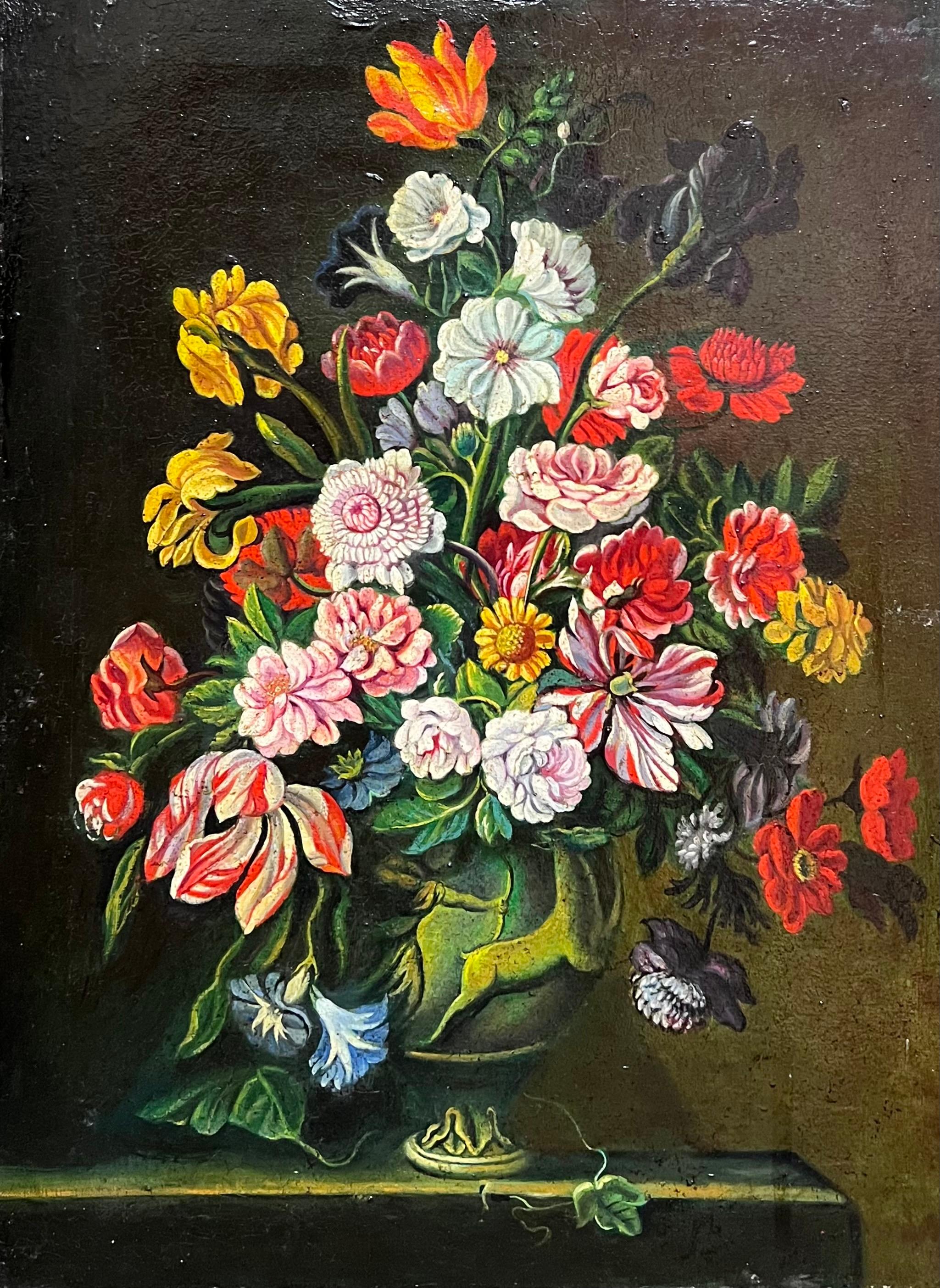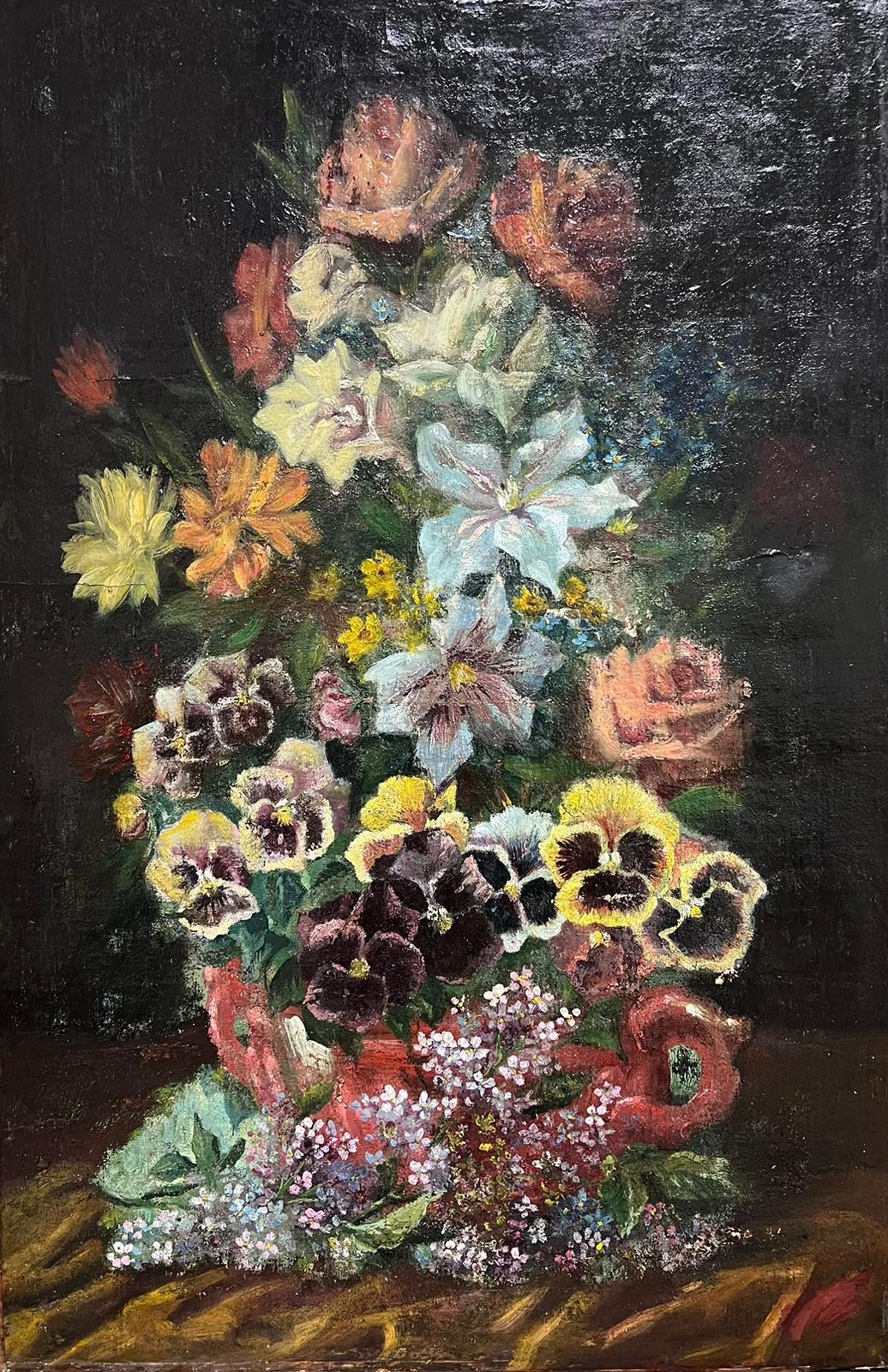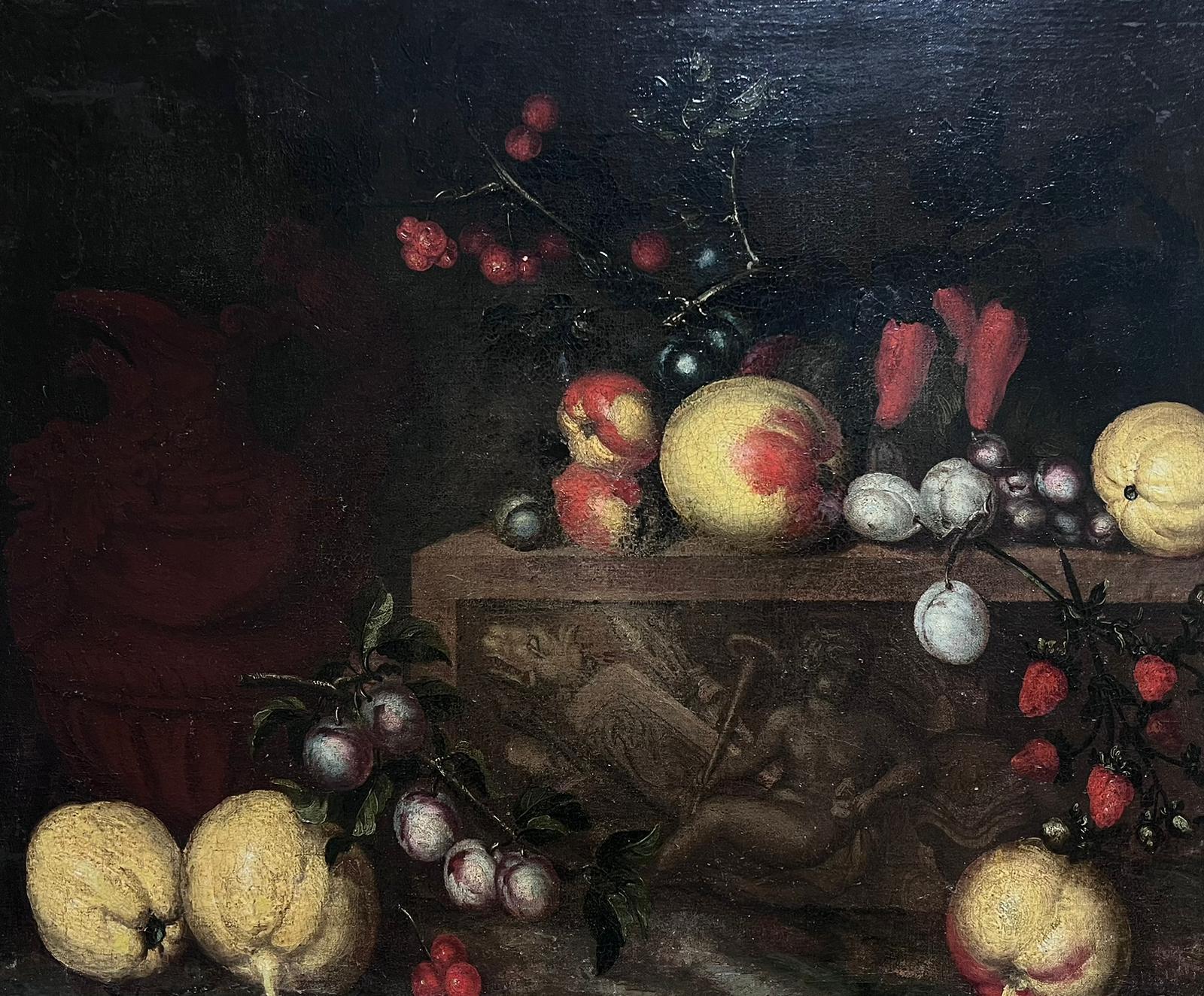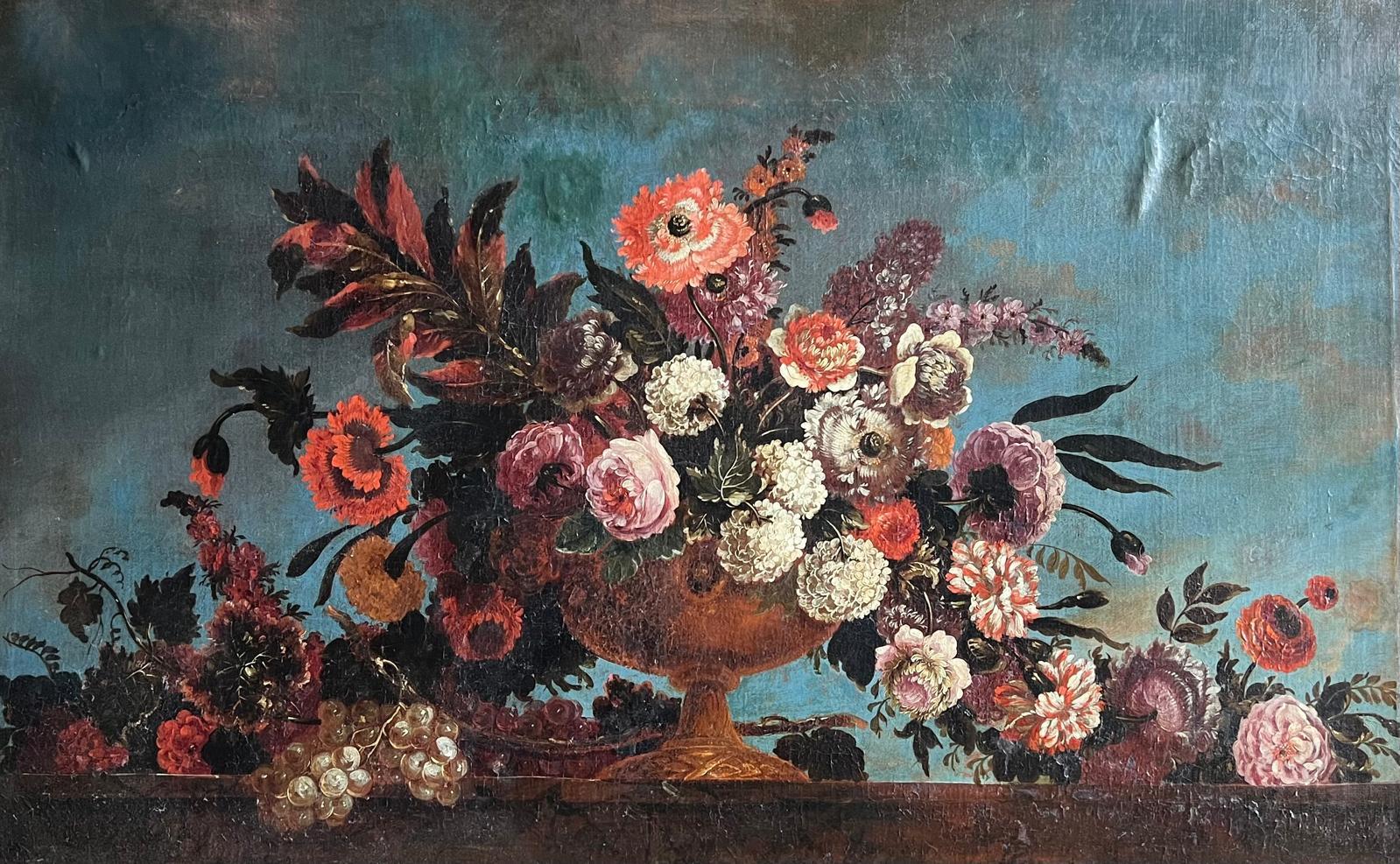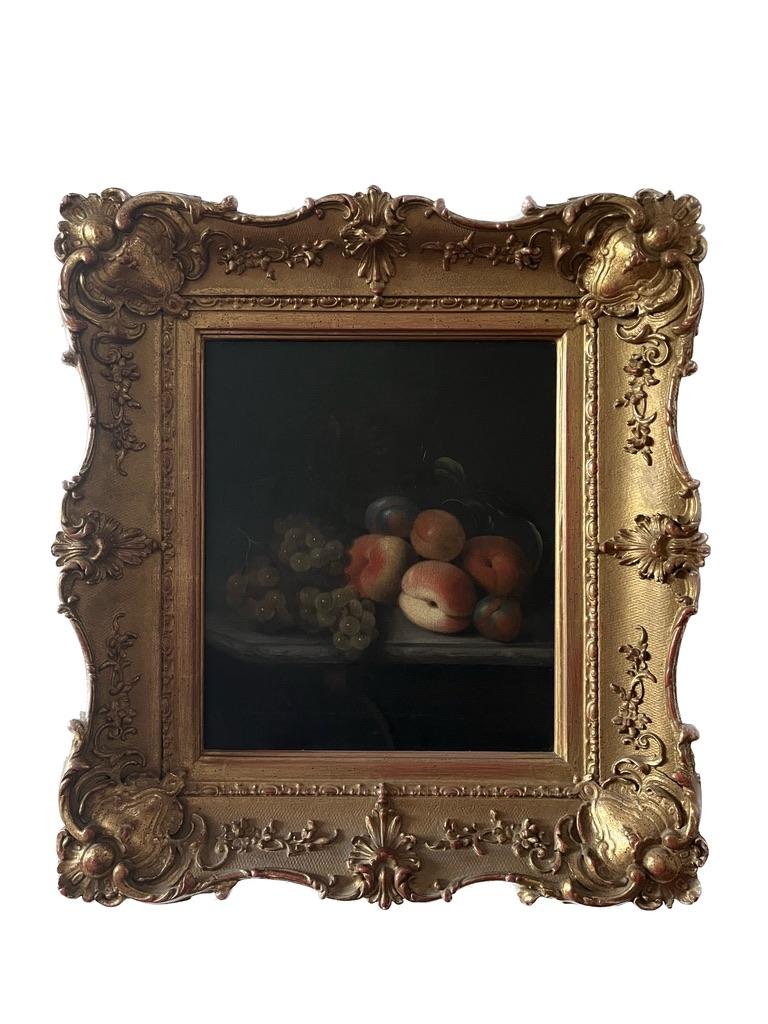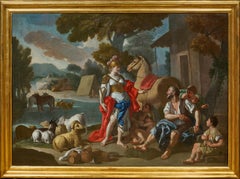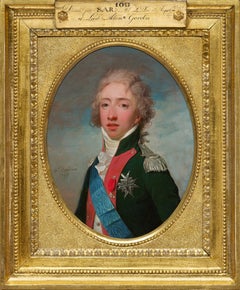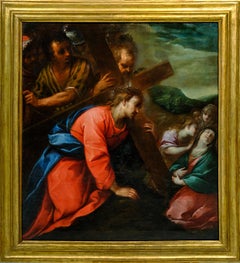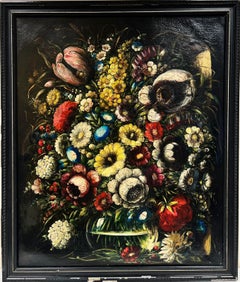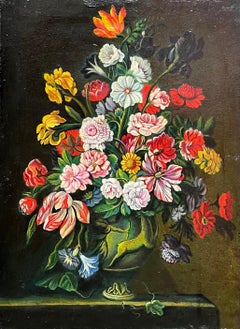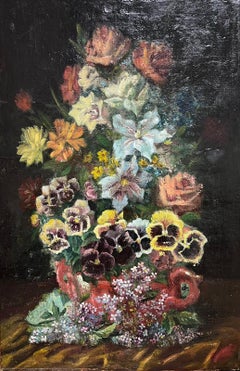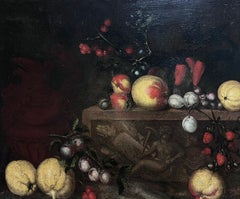Items Similar to Baroque silver Vase with Flowers with a Fruit Tray and a Clock by A. Zuccati
Want more images or videos?
Request additional images or videos from the seller
1 of 14
Adeodato ZuccatiBaroque silver Vase with Flowers with a Fruit Tray and a Clock by A. Zuccati2d half of the 17th century
2d half of the 17th century
About the Item
This unpublished composition is a recent addition to Adeodato Zuccati’s catalog. The study of this painting by Gianluca Bocchi, an Italian art historian specializing in Italian still lives, is available upon request.
This composition is typical of the productions of Adeodato Zuccati, an Emilian painter of the second half of the XVII century recently rediscovered. Echoing the Roman compositions of the first half of the century, it presents us with a sumptuous bouquet of flowers, accompanied by a tray of fruits and a clock that reminds us of the brevity of life.
1. Adeodato Zuccati, a recently rediscovered artist
The dates of Adeodato Zuccati's birth and death are not known with certainty because historical sources have passed on little information about this artist. Zuccati was a painter of flowers active in Emilia-Romagna in the second half of the 17th century, his paintings are listed in the inventories of the collections of aristocratic families of Bologna, such as those of Count Annibale Ranuzzi (1697) and Giovanni Antonio Sedazzi (1700).
In the second half of the 17th century, Antonio Masini described him as an "expert in painting flowers in their natural state", recalling that he had been active since 1668. In the 18th century, Marcello Oretti said that he was "perhaps a pupil of Pier Francesco Cittadini, known as the Milanese", while admitting that he was not familiar with his works. In the 19th century, Pietro Zani described him as a "painter of flowers".
The rediscovery of the Basin of Flowers on a Carpet by Luigi Salerno in 1984 allowed us to begin the reconstruction of his corpus. Traces of this painting have since been lost and we have only an old black and white photograph. The painting bears an eighteenth-century inscription on the back: "Del Zuccati Pittor celebre di Bologna". Although this is not a signature, the indication immediately seemed plausible because it is consistent with the information provided by Masini and Zani on his botanical inclination: almost half of the painting illustrated by Luigi Salerno is in fact occupied by flowers resting on an elegant fabric.
A painter of flowers, Zuccati enriched his repertoire by staging sumptuous fabrics, fruits and pieces of silverware. It is obvious that Adeodato Zuccati was influenced in Bologna by Pier Francesco Cittadini, also called the Milanese (Milan 1616 - Bologna 1681), and we find in his art the tradition of the Roman still lives seen by Cittadini during his stay in the Eternal City around 1640. In conclusion we can say that Zuccati realizes a synthesis of the different pictorial traditions of the Po Valley which, starting from Pier Francesco Cittadini in Bologna, end up with Antonio Gianlisi the Younger (Rizzolo 1677 - Cremona 1727), a painter active between Piacenza and Cremona at the beginning of the 18th century.
2. Description of the artwork
The entire composition is illuminated by a light source to the left of the painting. A first table, set at a slight angle, is covered with a green velvet fringed with gold, on which a heavy orange brocade has been laid. The light enhances the contrast between these two colours and emphasises the folds of the brocade.
On this richly adorned table, in the centre of the composition, is a monumental table clock, which one imagines to be made of gilded and silvered bronze. The front of the clock is decorated with a statue of Athena, helmeted and armed with a spear and shield. An allegory of Justice, recognisable by its scales, crowns the aedicula. The slightly trapezoidal shape of the sides indicates that this composition was intended to be placed high up and could have been used as a doorway.
To the left of the clock is a silver tray in which three varieties of fruit are represented: grapes, peaches and figs. A curtain appears at the top of the composition, casting a studded leather box with a cup on it into shadow. On this bowl rest two long tulips that seem to be wilting and two glasses, rendered ghostly by the transparency of the pictorial material.
The entire right-hand side of the composition is taken up by an opulent bouquet of flowers in a baroque silver vase placed on a saddle below the sideboard. As is often the case in flower paintings, the painter has brought together species that bloom in different seasons: hyacinths and tulips, lilies and peonies, roses and orange blossoms.
The entire composition is animated by a ternary rhythm: three horizontal planes (from left to right, the sideboard with the table clock and the tray of fruit, the cup on the studded leather case and finally the saddle on which the bouquet of flowers is placed), three main motifs (the bouquet, the table clock and the fruit), three types of fruit in the tray.
While still lives no longer systematically have a symbolic value in the second half of the 17th century, it seems interesting to us to relate this ternary rhythm to the three ages of Man. Youth could be symbolised by the bouquet of flowers placed in full light, and maturity by the rich tray of fruit on the left. Finally, old age could be evoked by the enigmatic composition that we can barely make out in the shadows: two tulips placed on the cup and two glasses, already half erased by time, whose inexorable march is recalled by the predominant presence of the table clock.
The figure of Athena could be interpreted as an exhortation to wisdom, which is necessary to lead one's life with dignity, while the Justice that surmounts the aedicula reminds us that our actions will be judged at the end of time.
3. Related work
It seems interesting to us to relate this painting to two other works by Adeodato Zuccati.
The first one is kept at the Galleria Estense in Modena and comes from the Palazzo Ducale of the same city. This painting seems interesting to us because we find two glasses on a tray in the lower right that are very similar to those presented in the upper left of our painting, half hidden in the shadow of the curtain.
The second (last photo in our gallery), presented for sale at Dorotheum in Vienna (October 12, 2011 - lot 434 - 30,000 euros with expenses) is particularly interesting. Bearing almost the same dimensions (91.5 x 143 cm) this painting has a very similar composition but on an inverted basis as if it were a counterpart to our painting. The large vase with flowers on a stone pedestal is on the left, the center and the right of the painting are occupied by a table covered with an Ottoman carpet on which, among other things, a baroque bronze statue and various pieces of silverware are placed. A curtain drapes the upper right corner of the painting.
The composition is again tripartite and offers a very similar combination of colors. The green of the curtain perfectly matches that of the tablecloth in our painting. The brightness of the silverware echoes those of the large baroque vase in which the bouquet is placed. The bright red of the fabrics, the brown with golden reflections of the bronze statuette evoke the clock with the effigy of Athena and the draperies of the brocade placed below.
- Creator:Adeodato Zuccati (Italian)
- Creation Year:2d half of the 17th century
- Dimensions:Height: 41.32 in (104.96 cm)Width: 61.44 in (156.06 cm)
- Medium:
- Movement & Style:
- Period:Late 17th Century
- Condition:35 1/8”x 55 1/8”(89 x 140 cm) (41 5/16”x 61 7/16” - 105 x 156 cm framed) Provenance : Country Estate in Aveyron (Occitanie - France) Italian 17th century carved and gilded frame Please contact the seller for additional shipping proposals.
- Gallery Location:PARIS, FR
- Reference Number:1stDibs: LU1568211769272
About the Seller
5.0
Vetted Professional Seller
Every seller passes strict standards for authenticity and reliability
Established in 2020
1stDibs seller since 2021
9 sales on 1stDibs
- ShippingRetrieving quote...Shipping from: PARIS, France
- Return Policy
Authenticity Guarantee
In the unlikely event there’s an issue with an item’s authenticity, contact us within 1 year for a full refund. DetailsMoney-Back Guarantee
If your item is not as described, is damaged in transit, or does not arrive, contact us within 7 days for a full refund. Details24-Hour Cancellation
You have a 24-hour grace period in which to reconsider your purchase, with no questions asked.Vetted Professional Sellers
Our world-class sellers must adhere to strict standards for service and quality, maintaining the integrity of our listings.Price-Match Guarantee
If you find that a seller listed the same item for a lower price elsewhere, we’ll match it.Trusted Global Delivery
Our best-in-class carrier network provides specialized shipping options worldwide, including custom delivery.More From This Seller
View AllErminia and the Shepherds, a painting by Francesco de Mura (Napoli 1696 - 1782)
By Francesco de Mura
Located in PARIS, FR
In this masterly painting, Francesco de Mura presents the meeting of Erminia and the shepherds, a famous episode taken from the seventh canto of Torquato Tasso's Jerusalem Delivered....
Category
1760s Old Masters Figurative Paintings
Materials
Canvas, Oil
Two royal portraits (the Duc d'Angoulême and the Duc de Berry) by H.P. Danloux
Located in PARIS, FR
These two royal portraits are a major historical testimony to the stay of the Comte d'Artois (the future Charles X) and his family in Edinburgh in 1796-1797. Given by the sitters to Lord Adam Gordon, the Governor of Edinburgh, and kept by family descent to this day, these two portraits provide us with a vivid and spontaneous image of the Duc d’Angoulême and his brother the Duc de Berry. Danloux, who had emigrated to London a few years before, demonstrate his full assimilation of the art of British portrait painters in the brilliant execution of these portraits.
1. Henri-Pierre Danloux, a portraitist in the revolutionary turmoil
Born in Paris in 1753, Henri-Pierre Danloux was first a pupil of the painter Nicolas-Bernard Lépicié (1735 - 1784) and then, in 1773, of Joseph-Marie Vien (1716 - 1809), whom he followed to Rome when, at the end of 1775, Vien became Director of the Académie de France. In Rome he became friends with the painter Jacques-Louis David (1748 - 1825).
Returning to France around 1782, he settled in Lyon for a few years before returning to Paris in 1785. One of his first portraits was commissioned by the Baroness d'Etigny, the widow of the former Intendant of the Provinces of Gascony, Bearn and Navarre Antoine Mégret d'Etigny (1719 – 1767). He then became close to his two sons, Mégret de Sérilly and Mégret d'Etigny, who in turn became his patrons. In 1787, this close relationship with the d'Etigny family was further strengthened by his marriage to Antoinette de Saint-Redan, a relative of Madame d'Etigny. After his marriage, he left for Rome and did not return to France until 1789. It was during the winter of 1790-1791 that he painted one of his masterpieces, the portrait of Baron de Besenval. Set in a twilight atmosphere, this portrait of an aristocrat who knows that his death is imminent symbolizes the disappearance of an erudite and refined society which would be swept away by the French Revolution.
The Jacobin excesses led Danloux to emigrate to England in 1792; many members of his family-in-law who remained in France were guillotined on 10 May 1794. Danloux enjoyed great success as a portrait painter in England before returning to France in 1801.
During his stay in England, Danloux was deeply under the influence of English portraitists: his colors became warmer (as shown by the portrait of the Duc d'Angoulême that we are presenting), and his execution broader.
2. Description of the two portraits and biographical details of the sitters
The Duc d'Angoulême (1775-1844) was the eldest son of the Comte d'Artois, the younger brother of King Louis XVI (the future King Charles X), and his wife Marie-Thérèse of Savoie. He is shown here, in the freshness of his youth, wearing the uniform of colonel-general of the "Angoulême-Dragons" regiment.
He is wearing the blue cordon of the Order of the Holy Spirit, which was awarded to him in 1787, and two decorations: the Cross of Saint-Louis and the Maltese Cross, as he was also Grand Prior of the Order of Malta.
Born on 16 August 1775 in Versailles, Louis-Antoine d'Artois followed his parents into emigration on 16 July 1789. In 1792, he joined the émigrés’ army led by the Prince de Condé. After his stay in Edinburgh (which will be further discussed), he went to the court of the future King Louis XVIII, who was in exile at the time, and in 1799 married his first cousin Marie-Thérèse Charlotte of France, the daughter of Louis XVI and the sole survivor of the royal family. The couple had no descendants. He became Dauphin of France in 1824, upon the accession to the throne of his father but played only a minor political role, preferring his military position as Grand Admiral. Enlisted in Spain on the side of Ferdinand VII, he returned home crowned with glory after his victory at Trocadero in 1823.
He reigned for a very short time at the abdication of Charles X in 1830, before relinquishing his rights in favor of his nephew Henri d'Artois, the Duc de Bordeaux. He then followed his father into exile and died on 3 June 1844 in Gorizia (now in Italy).
His younger brother, the Duc de Berry, is shown in the uniform of the noble cavalry of the émigrés’ Army. He is wearing the blue cordon of the Order of the Holy Spirit, awarded to him in May 1789, and the Cross of Saint-Louis (partly hidden by his blue cordon).
Born on 24 January 1778 in Versailles, Charles-Ferdinand d'Artois also followed his parents into emigration and joined the émigrés’ army in 1792. After his stay in Edinburgh, he remained in Great Britain, where he had an affair with Amy Brown...
Category
1790s Old Masters Portrait Paintings
Materials
Canvas, Oil, Wood Panel
View of the Grand Canal, a painting by William James, after Canaletto
By William James
Located in PARIS, FR
Although we have little bibliographical information on William James, we know that he was trained by Canaletto during the painter's stay in England between 1746 and 1755. Although he may never have been to Venice, William James remained under the influence of his master for a long time and became known for his paintings inspired by Canaletto's artworks.
In this painting, William James is inspired by one of the twelve views of the Grand Canal painted by Canaletto for Joseph Smith, or more precisely by the engraving made by Antonio Visentini in 1735 after this painting. He delivers a very personal version, vibrant with colours, in which he brilliantly reproduces the moving surface of the sea, animated by the ever-changing traffic of the gondolas.
1. William James, the English follower...
Category
Mid-18th Century Old Masters Landscape Paintings
Materials
Canvas, Oil
Christ Falling on the Way to Calvary, a painting by Carlo Francesco Nuvolone
Located in PARIS, FR
This painting by Carlo Francesco Nuvolone, the great Lombard master of the mid-seventeenth century, is striking for its dazzling composition and the brilliant colors of Christ's tuni...
Category
1640s Old Masters Figurative Paintings
Materials
Canvas, Oil
Mercury and Io, a rediscovered painting by Jean-Baptiste Marie Pierre (ca. 1740)
Located in PARIS, FR
We would like to thank Mr. Nicolas Lesur for confirming the autograph nature of the entire composition after a direct examination of the painting on November 27, 2024.
This painting...
Category
1740s Old Masters Figurative Paintings
Materials
Canvas, Oil
Judith and Salome, a pair of oil paintings on canvas by Francesco Conti
Located in PARIS, FR
This widely referenced pair of paintings is one of Francesco Conti’s most successful productions. Francesco Conti is one of the finest painters of 18th-century Florence. In the shimmering colors typical of his best work, he represents two opposite characters from the Bible: the virtuous Judith, whose courage saves her people by cutting off the head of the invader Holofernes, and the depraved Salome, who under the influence of her mother becomes responsible for the beheading of the prophet John the Baptist.
The artist's talent lies in his ability to treat these two macabre subjects with a light touch, presenting us with two attractive women who seem to twirl with glee amidst the severed heads...
1. Francesco Conti, the “Florentine Tiepolo”
Francesco Conti is a major painter of the Florentine school of the 18th century; he can even probably be considered, along with Giovanni Domenico Ferretti (1692-1768), as one of the two main painters of the second quarter of the Florentine 18th century.
Born in Florence in 1682, Francesco Conti began his apprenticeship in the workshop of Simone Pignoni (1611 - 1698), a disciple of Francesco Furini; he was also influenced by the Venetian Sebastiano Ricci. A protégé of Marquis Riccardi, he accompanied him to Rome between 1699 and 1705, where he frequented Carlo Maratta's studio. He settled permanently in Florence in 1705.
Painted exclusively on canvas, the majority of his work consists of religious subjects, altarpieces or private devotional works. It is likely that Conti himself was a devout churchgoer, as evidenced by his affiliation, in the third decade of the eighteenth century, to the Society of the Disciples of Saint-John-the-Baptist, and his entry, at the end of his life, into the fraternity of the Venerable Society of the Holy Trinity.
In Florence, Conti worked for the Grand Duchy's major patrons, including the last Medici - in particular Giangastone and Annamaria Luisa, Electress Palatine - and confirmed his role as a reference painter under the Lorraine Regency, as master of the Public Drawing School, which was closely linked to the institute responsible for the manufacture of semi-precious stone mosaics, then located in the Uffizi complex.
Matteo Marangoni, an art critic of the early 20th century, praised his "brushwork full of elegance and true spirit of the 18th century", pointing out that Conti was "probably one of the best colorists" of the Florentine school of his time. These two characteristics led the art historian Paolo dal Poggetto to nickname him the "Florentine Tiepolo".
2. Judith and Salome, two biblical characters opposing each other
These two paintings form a pair presenting two biblical episodes, which have in common the depiction of a "heroine" carrying the severed head of a man.
While the Salome episode might at first appear to be an echo of the Old Testament story of Judith, each character is the exact opposite of the other. Judith, whose story is told in the Book of Judith, is a beautiful young widow from Bethulia who, accompanied by her maid, went into the camp of the invading Assyrians and won the confidence of Holofernes, the general commanding the enemy army. Invited to a great feast on the fourth evening, she took advantage of Holofernes' drunkenness to cut off his head. “She went up to the bedpost near Holofernes’ head, and took down his sword that hung there. She came close to his bed, took hold of the hair of his head, and said, “Give me strength today, O Lord God of Israel!” Then she struck his neck twice with all her might, and cut off his head. Next she rolled his body off the bed and pulled down the canopy from the posts. Soon afterward she went out and gave Holofernes’ head to her maid, who placed it in her food bag...
Category
1710s Old Masters Figurative Drawings and Watercolors
Materials
Canvas, Oil
You May Also Like
Classical Still Life Flowers in Glass Bowl, Old Master Style oil on canvas
By German School
Located in Cirencester, Gloucestershire
German School, early 20th century
oil on canvas, framed
framed: 33 x 27.5 inches
canvas: 30 x 25 inches
private collection, UK
the painting is in overall very ...
Category
Early 20th Century Old Masters Still-life Paintings
Materials
Canvas, Oil
Fine Spanish Old Master style Oil Painting Flowers in Ornate Vase
Located in Cirencester, Gloucestershire
Classical Still Life of Flowers
Studio of Miguel Canals, Spanish 1925-1995
stamped with the studio mark verso
oil on canvas, unframed
canvas: 23.5 x 18 inches
Provenance: private col...
Category
20th Century Old Masters Interior Paintings
Materials
Oil, Canvas
Classical Still Life of Flowers Ornate Display Antique Dutch Oil Painting
Located in Cirencester, Gloucestershire
Profusion of Flowers
Classical Still Life
Dutch School, 19th century
oil on canvas, unframed
canvas : 32 x 21 inches
provenance: private collection
condition: very good and sound con...
Category
Late 19th Century Old Masters Still-life Paintings
Materials
Oil, Canvas
Fine 17th Century Still Life Oil Painting Italian Old Master Fruit on Ledge
Located in Cirencester, Gloucestershire
Ornate Classical Fruit Still Life
Italian School, 17th century
oil on canvas, unframed
canvas: 22 x 27 inches
provenance: private collection, UK
condition: very good and sound condi...
Category
17th Century Old Masters Still-life Paintings
Materials
Oil, Canvas
18th Century Huge Floral Still Life Oil Painting Depicting Bouquet Ornate Urn
Located in Cirencester, Gloucestershire
Bouquet of Flowers
French School, early 1700's period
oil painting on canvas, framed in antique gilt frame
framed: 37 x 54.4 inches
canvas: 30 x 47 inches
Provenance: private collect...
Category
18th Century Old Masters Still-life Paintings
Materials
Oil, Canvas
Rare 18th Century English Still Life of Grapes and Peaches
Located in Harkstead, GB
A rare and most attractive still life by William Smith of Chichester. The sumptuous textures of the peaches and grapes contrasting with the dark ba...
Category
18th Century Old Masters Still-life Paintings
Materials
Canvas, Oil
$4,888 Sale Price
44% Off
Free Shipping
Recently Viewed
View AllMore Ways To Browse
Antique Silver Vase
Antique Italian Still Life
Baroque Flowers
Baroque Material Used
Half Crown
Set Of 12 Botanicals
Folding Clock
19th Fruit Still Life
Fruit Tray
Fold Out Side And Has A
Velvet Tray
Old Silverware
Painting With Case On Table
Milanese Painting
Figural Trays
Folding Photo Frame
Old Man Bronze
Green And White Tray

